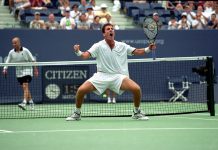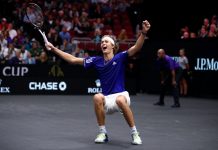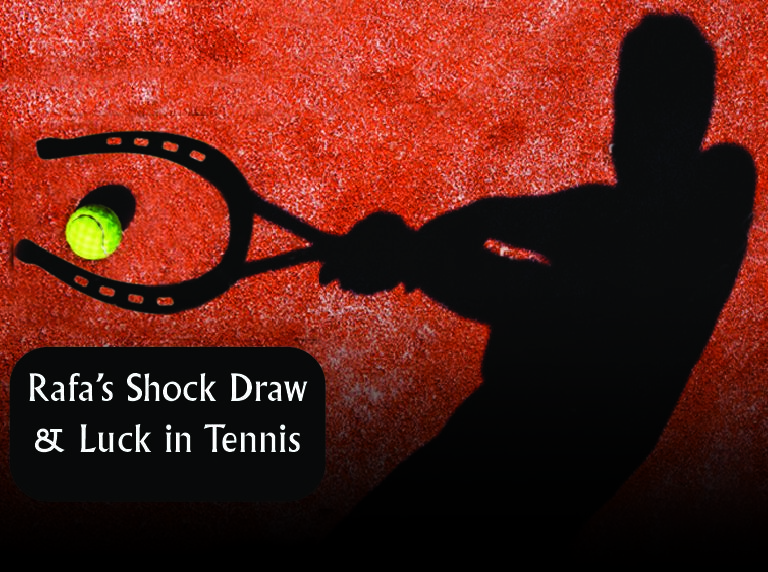Paul Torricelli spent a quarter century at Northwestern, where he guided the Wildcats to a 343-257 mark between ’84 and ‘07, including a pair of undefeated Big Ten campaigns and a coveted conference championship. The native Northern Californian, who found his calling while working with Bay Area coaching legends Dick Gould and Tom Chivington in the early ’70s, has done some mentoring of his own. Six of his former assistants have graduated to the head coaching ranks: Jay Udwadia runs the men’s program at Fresno State; Greg Davis took over the women’s program at Louisville; and Adam Steinberg led the Pepperdine men to the NCAA title in ’06. Plus former players Geoff Young (Minnesota) and Arvid Swan (Northwestern) followed his lead into the coaching ranks, too, not to mention those who have risen to the top of the sport on the ATP Tour, including Todd Martin. Today, the three-time Big Ten Coach of the Year is the tennis director at the 19-court Harbor Bay Club in his old stomping grounds of Alameda, Calif., where he’s busy launching a variety of tennis initiatives. The Oakland-born Torricelli, who was introduced to the sport on the courts of San Leandro High School as a budding junior and went on to play (and later coach) at Chico State, remains more than active on the collegiate tennis scene, working closely with the ITA and serving as a consultant with Scholarship For Athletes, an organization that specializes in guiding college-bound athletes through the recruiting process.
INSIDE TENNIS: It’s an interesting time for college tennis right now, to say the least. There’s a real global mix on the rosters of many top programs, our top players are often skipping college, and many kids who grew up in the game and played competitively are putting their rackets down for good when they head off to school. Tell us about your role with Scholarship For Athletes.
PAUL TORRICELLI: Recruiting has never been more complicated and daunting for these families. I would say 98 percent of the kids coming out who want to go to college, regardless of their ranking, need some kind of effective guidance and counseling, navigating the recruiting process. We help families do that in a straightforward and personal way.
IT: Are we solely talking about the top kids?
PT: No, I’m talking about every kid. The top kids need help, but so do the ones who fall between the cracks, who are not heavily recruited. There’s a place for just about every kid to play in college. There are so many schools.
IT: Another Northwestern man, who I understand is a good friend of yours, is heading into his first year as president of the USTA — Jon Vegosen. I know college tennis is a big item on his agenda, both in saving NCAA programs from the cutting floor and pushing the USTA’s Tennis On Campus program, which gives students who aren’t necessarily scholarship material a chance to play.
PT: There are a lot of programs. You don’t have to be a great tennis player to play in college. There are so many schools, small schools. It’s not just the elite Division I schools, the strong Division II schools or the elite Division III schools. There are all kinds of levels, sort of a stratum at each level where you can play. You might find a very obscure school that happens to have a good academic program and is looking for players. A lot of kids assume, ‘Well, if I can’t play at Stanford, I can’t play in college.’ The reality is they have a lot more choices than they realize if they’re willing to look and so some homework. We help them navigate the process. It was started by a guy named Ross Greenstein, who played at Florida and had a really good experience, but he was aware of a lot of kids who weren’t having good experiences.
IT: So maybe there’s a kid who finishes No. 49 sectionally in his age group who’s not D1 material, but there might be a place for them at a small liberal arts school in New England that they might not know about?
PT: Exactly. Then he finds out about it, goes and takes a look and the coach is interested. You begin to broaden your range of schools. My role as a consultant is to help the families know how to talk to coaches, to know what coaches are really looking for. There are so many teaching pros out there who are really good coaches, but it’s hard to stay familiar and up-to-date with college tennis. It’s much tougher and more competitive than it ever was. There are more good programs than ever. D3 is much tougher and deeper than it used to be. You’ve got some small schools now that are really good. Families need help.
IT: Here’s a hot-button topic that I’m sure you’re asked about all the time, but I was wondering where you come in on the debate over the growing number of foreign-born athletes who are filling up roster spots and capitalizing on scholarship opportunities in the U.S. For example, the University of Pacific’s ENTIRE men’s roster is made up of kids from outside the U.S. Some say it’s good competition, while others see missed opportunities for our kids.
PT: They’re both right. It’s not a simple thing. I coached for 24 years at Northwestern. If I could do one thing over again, I would have recruited more foreigners.
IT: Because that would have led to more titles?
PT: Almost every college coach I know would have preferred to recruit Americans, but we’ve got to get American juniors better. There’s a real commitment to doing that. American juniors in the past have tended to come out of the juniors not as polished, as well rounded. As a coach, with your livelihood depending on it, do you want the high maintenance, immature 18-year-old American kid, or do you want the kid from Europe who’s more mature, more poised, more worldly, a better all-around player, is going to be at practice on time, knows how to make his bed and do his laundry? They’re lower maintenance. We breed immaturity in this country. There are tons of exceptions. Most coaches would prefer Americans, but we’ve got to get them better. We’ve got to train them better. This whole 10-and-under tennis push is part and parcel of that. The same parent who complains about it — ask them who their favorite NBA team is. Ask them who their favorite college basketball team is. Ask them where they went to school and tell them to look at the swim roster, track roster, soccer roster. It’s the way of the world. Walk on any college campus and there are 50-60 nationalities represented. This is our country. And this is an incredibly international sport. Rather than worry about all that, let’s just get the Americans better. But I’ve never heard an American college tennis player complain about the international guys on his team — not one. It’s a win-win.
IT: But there are still the Stanfords of the world who are still capable of grabbing the top Americans and not necessarily having to go beyond our borders for top talent.
PT: Right. But if you’re the coach at Mississippi State, a very good tennis program, SEC, arguably the best conference in the country, you CAN’T be competitive recruiting Americans. They’re not going to go to Starkville, Mississippi. They’re going to snub their noses at it. You may pick up a couple of guys, but you’re mostly going to have to do it internationally.
IT: But this isn’t a big-money sport like football or basketball that brings in the dollars to these schools. There’s not really the same pressure to win, and college coaches therefore don’t have to worry about their jobs the way some other coaches do. Win or your job is on the line.
PT: That’s changing. It’s becoming more of a high-pressure sport. All college sports are under the microscope more than they ever were. You’re going to see more changes. You’re going to see fewer coaches staying a lifetime in one place. There are expectations there now. So of course you’re going to go out and get the best player you can get. It’s a pain to recruit foreigners. There’s a lot more work. It’s not easy, not a slam-dunk. It’s not like you’re going out and getting a hired hand. You’ve got to fill out the I-9 Form, and a visa. There are all kinds of hoops to jump through as opposed to taking the kids from the next town. But there’s a reason they do it. College tennis is full of American kids who weren’t the top juniors who got to college and have made contributions to their team. That happens all the time, too. It’s a nice mix. I think you’d hear the same stories in other sports.
IT: As far as the Americans kids are concerned, there was a day when McEnroe, Connors, Ashe, etc. chose college tennis. Now our top kids are opting for the professional route. Sam Querrey nearly headed to USC, but chose the ATP Tour. Donald Young turned pro at 15. Should they be giving college a chance?
PT: Yes. I think they clearly should. Most of the juniors could and should at least spend some time in college just in terms of maturing. There are obvious exceptions, but the USTA is really embracing college tennis as part of the pathway to developing world-class players. A little time in college, if you’re that good, can only help. Teenage American males are immature. Our society does not do the kind of job it could do. They’re less worldly. They get to college and are woefully unprepared. If you’re that good a year or two into college, you can get out there and make a splash. It’s gives you a sense of who you are. You’ve got the team aspect of it, which is huge.
IT: Look at James Blake. He may be sliding in the rankings, but he can always go back to finish his degree at Harvard. That’s not a bad backup plan.
PT: Yeah. And they have this tremendous loyalty and affection for their college team, their coaches — even if it’s only two years. Todd Martin only had two years at Northwestern, but his teammates are like his brothers. We had a reunion this summer. I can’t imagine a group of guys being closer than he is with his teammates. So there’s a lot to be said for it. Could Donald Young have benefited from it?
IT: In hindsight, yes.
PT: The tennis world is littered with promising juniors who took a run at it and vanished — really good players. They could have benefited from a year or two – or maybe four. John Isner‘s out there. You’ve got coaches who are committed to helping you, who want you to go out and be a successful pro. They’re going to give you their blessing. Now I feel like the USTA is back promoting college tennis to at least be considered. At the end of the day, in this country, you still have to have a degree to make a living.
IT: You mentioned Todd — you had some great players come through that program. What other names stick out for you?
PT: The most important might be Doug Bohaboy [the Mountain View, Calif. native was ranked among the top 50 in the nation throughout his four years under Torricelli, was named Big Ten Sportsman of the Year as a senior and later rose to a career-high No. 250 on the ATP Tour in ’03]. We’re very close. He went to Palo Alto High School and used to ballboy at Stanford. In those days, Stanford was so good that [former head coach] Dick Gould didn’t have to worry about recruiting him. I don’t think [current head coach] John Whitlinger would let him get out of town now. But nobody expected Doug to be as good as he was. We got very lucky there. He did an amazing job for us.
IT: Todd is the odd man out whenever people mention the Fab Foursome of Sampras, Agassi, Courier and Chang. People forget that he reached the Australian and U.S. Open finals. Did you know he was going to be that good back then?
PT: I’d be lying if I said the skinny guy in the back of the van was going to turn out to be in the top five in the world. But you knew there was something special there. By his sophomore year, he was the No. 1-ranked college player in the country. An agent told me he could be top 30, and I was floored. I thought he could be top 100, but Todd knew where he was headed. The great ones always know intuitively what their level is. He never would have verbalized it, but he proved it right. As good a player as he was, he’s a better human being. Very early in his career, he started a foundation in Lansing, Michigan — the Todd Martin Development Fund — which is prospering and flourishing. He’s a very giving person.
IT: We touched on Jon Vegosen earlier, but tell me what kind of guy he is.
PT: Jon is a very global thinker. He has a vision for American tennis, both recreationally and competitively. He wants to see us developing more world-class players in a systematic way. He’s clearly made a commitment to college tennis. He’s played a big part in that over the last few years. Jon just loves everything there is about tennis. I don’t think there’s one aspect about tennis in America that he won’t touch. He’s a tireless worker. He’s got a great mind. His son, Spencer, was ranked No. 1 in the country and played at Harvard — much to Jon’s chagrin. [Laughs.] He wanted him to play at Northwestern. I wanted him to play at Northwestern. He comes form a wonderful tennis family. I’m excited to have him as our leader.
IT: Now that you’re jumping back into more of a grassroots scene at Harbor Bay, what are some of your goals?
PT: I love the location, and with 19 courts, we’ve got a chance to grow our USTA League teams, create more programs for the membership, and we’re on a mission to attract more members. We want to make a big commitment to 10-and-under tennis. We’ve got an elementary school a block away [Earhart Elementary], and another one a few minutes away. We want them to know that this is a place where you come to learn the beginning stages. We have the very beginnings of a high-performance program. We’re starting to do some drill sessions. We can complement what some of the top juniors are already doing. I’ve hired [former Cal All-American and NCAA doubles champion] Amy Jensen as a teaching pro. I’m excited about having her here. I’m talking with Charlie Hoeveler [of U.S. Sports Development] about bringing is some Nike Tennis Camps. We really want to push the envelope.



















